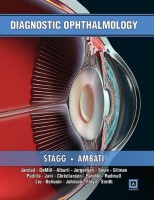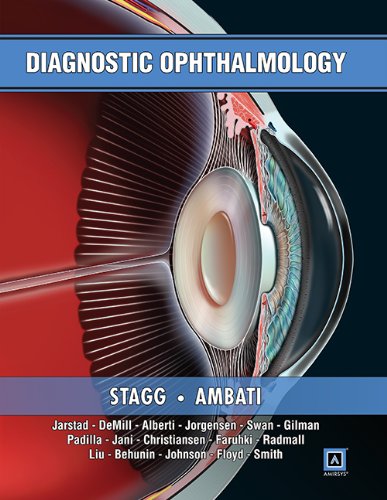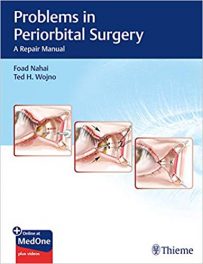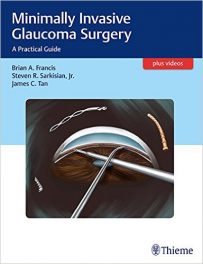 Editors-in-Chief: Brian Stagg, MD and Balamurali K. Ambati, MD
Editors-in-Chief: Brian Stagg, MD and Balamurali K. Ambati, MD
Image Editor: James Gilman, CRA, FOPS
Publisher: Wolters Kluwer | Lippincott, Williams & Wilkins – 1,000 pages
Book Review by: Nano Khilnani
This is a refreshingly unusual book. It is radically different from most others. Instead of presenting detailed discussions of various topics, it simply lays bare, with text and images, the important pieces of information needed for analysis of the problem, diagnosis, and treatment options. It saves you one of the most valuable resources you have that is in such short supply these days: time.
While we admit that discussions used in other books serve important purposes, we assert that the format of this book has advantages in presenting information in concise and helping students learn it quickly and retain it effectively for easier recall later.
Using bullet points, headings, outlines, numbering, tabs, and summaries, this book enables you the medical student, resident or practitioner look at, in a single or several snapshots, all the relevant aspects of a particular disease or disorder. Actual color photos of eye diseases and disorders in patients, as well as clear line drawings of eye anatomy make learning and remembering easier.
There is no better way to explain to you how useful this book and its format are, than to give you an example of what you will find in a typical section. So let’s take a look at the very beginning of the Table of Contents: Conjunctiva Overview written by Dr. Pooja Jani in Section 1, Conjunctiva, in Part I, Cornea and External Disease.
You will find the material in Conjunctiva Overviewpresented to you in this outline form:
Terminology
- Definitions (two bullet points: first one describes it as a “thin translucent mucous membrane lining inner surfaces of eyelids,” and the second one informs us of its anatomical range as “reflected onto the exterior surface of the eye to extend from the anterior episclera and sclera to the limbus of the cornea, where it becomes continuous with corneal epithelium.”
Conjunctival Function
- Clinical Importance (various functions presented in bullet points below this tab)
Embryology
- Development (presents in bullet-point format, how conjunctiva develops from birth)
Gross Anatomy
- Anatomical Features (descriptions of conjunctival subdivisions in outline form)
Histology
- Layers (details the structures and functions of the conjunctival epithelium)
Conjunctival Vasculature
- Vessels and Lymphatics (descriptions of the blood vessels and blood flow)
Conjuntival Innervation
- Nerve Supply (describes sensory innervations, pain and inflammation)
Normal Ocular Flora
- Organisms and Defense (describes defense mechanisms protecting conjunctiva)
Conjunctival Inflammation
- Common Signs (presents in bullet points, and describes: discharge, papillae, follicles, chemosis, hyperemia; involvement of conjunctival, episceral and ciliary vasculature)
Related References (presents five sources of further study of conjunctiva)
The book consists of eight Parts and 18 sections. Here is an overview of its coverage:
Cornea and External Disease
- Conjunctiva
- Sclera
- Cornea
Lens and Cataract
- Cataracts and Other Disorders of the Lens
Glaucoma
- Open-Angle Glaucoma
- Closed-Angle Glaucoma
Uveitis and Ocular Immunology
- Iris
- Uveal Tract
Vitreoretinal Diseases
- Vitreous
- Retina and Choroid
Ophthalmic Plastic Surgery
- Eyelids
- Lacrimal System
- Orbit
Neuroophthalmology
- Optic Nerve
- Ocular Motility and Cranial Nerves
- Central Nervous System Visual Disorders
Pediatric Ophthalmology
- Congenital Anomalies
- Strabismus
You can access the entire contents of this book plus additional materials through Amirsys eBook Advantage. Do the following:
- Scratch off silver coating on the inside front cover of your book to get your license key
- Go to: http://ebooks.amirsys.com
- Existing users: log in to your account
- New eBook Advantage users: Register for a new account
- Register your title with this license key
(You may need to log out and log back in to see your new eBook in your list of registered titles)
With Amirsys eBook Advantage , you get the following features:
- Searchable content
- Expanded diagnostic tops and references
- Additional annotated images
- Summaries of relevant clinical studies
Drs. Brian Stagg and Balamurali K. Ambati have done an excellent job in designing this book, compiling its materials, a lot of it authored by young trainees, and presenting them in a format that is effective for learning. My earliest experience in high school, in a class in English Literature, proved to me that outlining a chapter’s material helps you learn and recall it more easily than in any other way.
Editors-in-Chief:
Brian Stagg, MD is ophthalmology resident in the Department of Ophthalmology at Moran Eye Center at University of Utah School of Medicine in Salt Lake City, Utah.
Balamurali K. Ambati, MD, PhD, MBA is Professor of Ophthalmology and Director of Cornea Research at Moran Eye Center at the University of Utah School of Medicine in Salt Lake City, Utah. Dr. Ambati holds the distinction of being the world’s youngest person to graduate from medical school at the age of 17.
Image Editor:
James Gilman, CRA, FOPS is Image Editor and Project Administrator at Moran Eye Center at the University of Utah School of Medicine in Salt Lake City, Utah.
Contributing Authors:
Gustav N. Alberti, MD; Nicholas Behunin, MD; Ashlie Bernhisel, BA; Steven M. Christiansen, MD; David DeMill, MD; Nathan Eshenroder, BS; M. Aabid Farukhi, BA; Anne Margaret Floyd, MD, MS: Joshua R. Ford, MD; Isha Gupta, BS; Pooja D. Jani, MD; Allison R. Jarstad, DO; Jason Jensen, BS; Jerica Johnson, BS; Adam Jorgensen, MD; Justin C. Kohl, MD; Nathan Lambert, BS; Erica Liu, MD; Maximillian R. Padilla, BS; Bryce Radmall, MD; Cecinio Ronquillo Jr., PhD; Christopher B. Smith, MD; Shannon L. Stallings, MD; Russell Swan, MD; and James Tucker, PhD.
Image Contributors:
Erin E. Anstadt, BA; Jacob K. Barney, BS; Jefferson R. Brown, BS; Stephen J. Campbell, BS; Edward N. Feinberg, MD, MPH; Bradley S. Henriksen, BS; Stephen Craig Morris, BS; Henry Daniel Perry, MD; Christopher E. Starr, MD, FACS; Amith C. Subhash, BS; Noelle M. Teske, MSc, BA; and Albert Y. Wu, MD, PhD.







